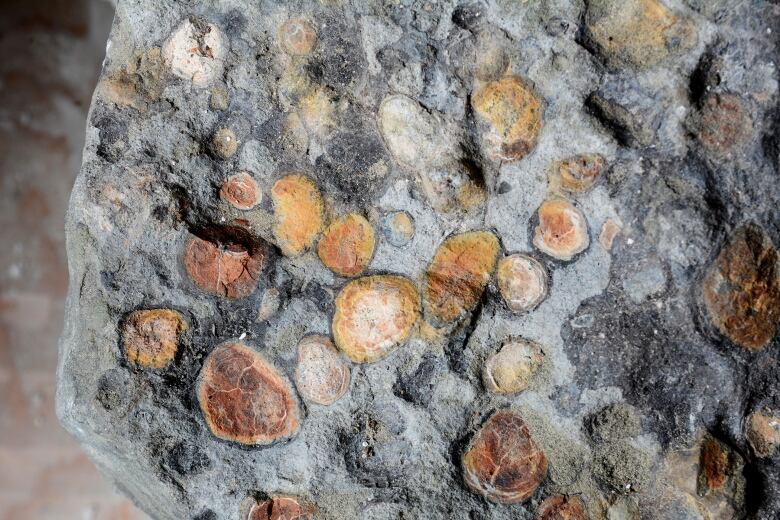A beautifully preserved armoured dinosaur found in an Alberta oilsands mine died on a full stomach. The "extraordinarily rare" preservation of its last meal offers new clues and surprises about how the dinosaur lived during its last days.
The 5.5-metre-long, 1,300 kilogram spiky, plant-eating nodosaur, similar to an ankylosaurus but without a tail club, is the only known one of its species, Borealopelta markmitchelli. (Its name means "shield of the north" and honours Mark Mitchell, the technician who spent 7,000 carefully extracting the fossil from the surrounding rock).
The nodosaur lived 110 million years ago during the early Cretaceous, in a lush forest of conifers, ferns and palm-like plants called cycads, near the coast of what was then an inland sea. At the time, the climate was warmer, similar to that of South Carolina, said Caleb Brown, a paleontologist at the Royal Tyrrell Museum of Paleontology in Alberta and lead author of the new study. It was published this week in the journal Royal Society Open Science.
The fossil was discovered by accident in 2011 by Shawn Funk, a shovel operator at the Suncor Millennium Mine near Fort McMurray. Paleontologists from the Royal Tyrrell were called to have a look and realized at once that it was no ordinary fossil.
While most fossils include only bones, this one included skin. It was so well-preserved that it has been described as "mummified."
In the dinosaur's belly, "there were these massive concentrations of what looked like rocks," Brown said.
Those were in a mass about the size of a soccer ball, and it appears they were gastroliths — rocks that some plant-eating dinosaurs use to grind up their food in their stomachs, as modern birds do, instead of using their teeth.
Sure enough, when chunks of the mass were encased in resin, sliced and examined under the microscope, the researcher could see well-preserved twigs, leaves, mosses, pollen and spores.
To get some help at identifying the plant material, the dinosaur researchers turned to paleobotanists, including University of Brandon researcher David Greenwood and his team, along with their retired Royal Tyrrell colleague Dennis Braman.

Ferns and charcoal
They discovered that the dinosaur was a bit of a picky eater. While it lumbered through a landscape that was lush with conifers, horsetails and cycads, there weren't a lot of those in its stomach.
"It's almost all ferns," Brown said, noting that ferns aren't actually very nutritious. "It wasn't just hoovering up everything on the landscape."
But to him, the biggest surprise was that the stomach also contained a significant amount of wood, mostly charcoal, suggesting it was feeding in an area that had recently been ravaged by wildfires.
"And that's a really cool result," Brown said. "Because if you look at large mammals that are herbivores today, they often seek out areas that are recovering from forest fires."
That's because the new growth tends to be lush, more nutritious than older plants, and low to the ground where it's easily accessible.

Forensic paleobotany
By looking at the types of spores and the fact that the twigs appeared to be in the middle of their growing season, the researchers figured out that the animal died during the wet season, which was late spring or early summer.
In Dinosaur Cold Case, a recent documentary about the fossil on CBC's Nature of Things, Greenwood said extreme storms and flash floods would have been a problem at that time of year on the coastal plain where the dinosaur and suggested that being swept away by rushing water may have been what caused its death.

The discoveries about the nodosaur's last meal are significant because to date, Brown said, "we know almost nothing about what herbivorous dinosaurs eat."
Only guesses can be made based on what plants lived nearby and the dinosaur's teeth. There are also clues in fossil dinosaur feces, but the plant material in those are often digested beyond recognition and it's difficult to know which dinosaur they came from.
Part of the problem is that finding preserved stomach contents from a dinosaur is "extraordinarily rare," Jim Basinger of the University of Saskatchewan, a co-author of the study, said in a statement.
Nine cases of possible dinosaur stomachs of plant-eating dinosaurs have been found, the researchers note, but most have turned out to just be plant material found nearby rather than actual stomachs. In this case, the dinosaur was washed far out to sea, without any plants from the landscape it lived in, before it was fossilized.
"So in this case we have what I would say is by far the best evidence that these are stomach contents," Brown said.
That said, he notes that it may not necessarily be representative of what this species normally ate, as an animal's diet can vary depending on its age, its health, and the seasonal availability of different foods.
Still, he said it's useful to be able to compare it to what scientists think plant-eating dinosaurs were eating at that time and raises new questions to investigate, such as: How much of this food a dinosaur this size would have needed to eat to sustain itself? And how did it digest it?
"I think give us a benchmark for figuring out how this animal may have lived."
https://news.google.com/__i/rss/rd/articles/CBMiSmh0dHBzOi8vd3d3LmNiYy5jYS9uZXdzL3RlY2hub2xvZ3kvbm9kb3NhdXItYm9yZWFsb3BlbHRhLXN0b21hY2gtMS41NjAwMjI00gEgaHR0cHM6Ly93d3cuY2JjLmNhL2FtcC8xLjU2MDAyMjQ?oc=5
2020-06-05 19:44:00Z
CBMiSmh0dHBzOi8vd3d3LmNiYy5jYS9uZXdzL3RlY2hub2xvZ3kvbm9kb3NhdXItYm9yZWFsb3BlbHRhLXN0b21hY2gtMS41NjAwMjI00gEgaHR0cHM6Ly93d3cuY2JjLmNhL2FtcC8xLjU2MDAyMjQ
Tidak ada komentar:
Posting Komentar